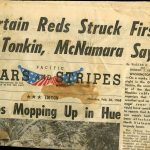All photos and scans are a part of the Beverly Deepe Keever Collection at the University of Nebraska-Lincoln Libraries- Archives and Special Collections
Beverly Deepe Keever spent 7 years writing, reporting, and photographing the Vietnam War, but exactly how much work is it to write just one article? What was different about 1960s journalism? How did being a woman affect the job of being a correspondent? These are some of the questions people may have when studying a time like this so that is why we put together a short section here that walks through the process of an average article by Bev Keever. As you look through the different notes and files please note that this is not a direct process of one single article, rather it is the best we could find of several articles Keever was writing around the same time (January and February, 1968) and on the same topic (Tet Offensive and Blitz).
Notes:
These are two examples of short-hand notes that Keever would write as she was gathering information for an article. Keever would use small notebooks like these and take notes in her own unique style of shorthand (no one can read it, even Keever can’t figure out what they say anymore). Keever would take notes on many different things: press briefings, other articles, interviews, or even just what she observed in the field. The Keever Collection in the University of Nebraska Archives has dozens of these small notebooks filled with notes that Keever was almost constantly taking.
News Releases:
News releases like these were offered regularly to the press. They would outline major events from the day, week, or month and would be released by the Army, Navy, and Air Force to any member of the press that wanted them. These news releases provided crucial information to journalists and would help paint a big picture of what was going on throughout all Vietnam and gave vital information about important events that would be important as journalists were writing articles and reports. Press briefings were also available to members of the press in Saigon every day at around 5:00. These press briefings would outline the major events in the day, even the bad news from the US military. The press nicknamed these briefings the “5 O’clock Follies.”
Other Newspapers:
A big part about being a journalist was reading other people’s writings and stories to get a better sense of what was going on in Vietnam and how to improve their own writing. Here is an example of one of the many newspapers from Vietnam that Keever collected over the years. This is an issue of Stars and Stripes, a military newspaper designed for military personnel. This newspaper also provided crucial information for journalists as they were developing their own, independent stories.
Article Rough Drafts:
Once Keever would collect all her notes, releases, interviews, and all other information, it was time to write an article. Here are a few examples of the first pages of some of these rough drafts. After slight editing and finalization, Keever would send these articles back to the US via cable or leased wire service.
Thank You Telegram:
After receiving the article by cable, the main office would often send back a confirmation telegram thanking Keever for the article. Sometimes they would give her information on if or when the article will be published. Here is an example of a telegram from Boston signed “Johansson.” The cable came from the main office of The Christian Science Monitor.
Publication:
Here are two copies of the front page of The Christian Science Monitor, one of the news outlets Keever worked for while in Vietnam. Keever’s articles make appearances on both of these front pages. From here, the newspapers would be distributed, and Keever’s articles would be read all around the country and around the world.












